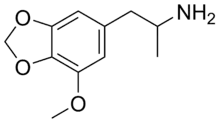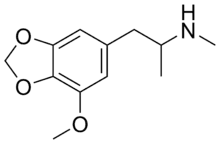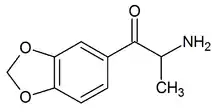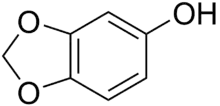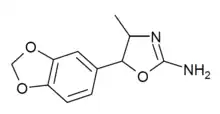
Substituted Methylenedioxyphenethylamines (abbreviated as MDxx) represent a diverse chemical class of compounds derived from phenethylamines. This category encompasses numerous psychoactive substances with entactogenic, psychedelic, and/or stimulant properties, in addition to entheogens. These compounds find application as research chemicals, designer drugs, and recreational substances.[1]
The base compound of the MDxx class is 3,4-methylenedioxyphenethylamine (MDPEA), and the prototypical agent of this class is 3,4-methylenedioxy-N-methylamphetamine (MDMA; "ecstasy"). Other mentionables include 3,4-methylenedioxyamphetamine (MDA), 3,4-methylenedioxy-N-ethylamphetamine (MDEA; "Eve"), N-methyl-1,3-benzodioxolylbutanamine (MBDB; "Eden"), and 3,4-methylenedioxy-N-methylcathinone (βk-MDMA; "Methylone").
List of substituted methylenedioxyphenethylamines
The compounds most commonly regarded as comprising the family of MDxx derivatives include:
Related compounds
In addition, there are a number of other compounds that have some structural and pharmacological similarities to the methylenedioxyphenethylamines, and are useful for comparison. These can be broadly divided into (i) compounds where the methylenedioxyphenyl ring is retained but the phenethyl portion is modified, or (ii) compounds which retain the 3,4-cyclised amphetamine core common to the MDxx compounds, but have the 1,3-benzodioxole ring replaced by related heterocycles.
See also
References
- ↑ Trachsel D, Lehmann D, Enzensperger C (2013). Phenethylamine: From Structure to Function. Nachtschatten Verlag AG. ISBN 978-3-03788-700-4.
- ↑ Dr. Matthias Grill, Novel Safrylamine derivates having prodrug properties. Patent WO 2022/053696
- ↑ Świst M, Wilamowski J, Zuba D, Kochana J, Parczewski A (May 2005). "Determination of synthesis route of 1-(3,4-methylenedioxyphenyl)-2-propanone (MDP-2-P) based on impurity profiles of MDMA". Forensic Science International. 149 (2–3): 181–92. doi:10.1016/j.forsciint.2004.06.016. PMID 15749360.





.svg.png.webp)





